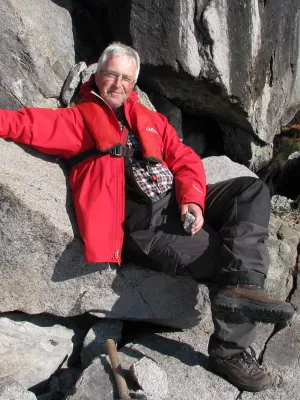
Leif Johansson
Professor emeritus

Determination of magnetic properties of rocks by analysis of demagnetization curves: Hematite-ilmenite bearing rocks from SW Sweden
Author
Summary, in English
Granulites from the high-grade Sveconorwegian (corresponding to Grenvillian) gneiss terrane of SW Sweden were investigated in order to relate magnetic properties to the granulite facies mineralogy and the amphibolite facies retrograde mineralogy. We used standard paleomagnetic techniques, susceptibility measurements, electron and optical microscopy, and a new way to analyze demagnetization curves based on vector difference sums. The new technique allowed quantitation of the relative contributions of partial natural remanent magnetization (NRM) components as well as numerical extraction of thermal and coercive force (alternating field, AF) unblocking data. Two major components were identified, one stable which is carried by hematite-ilmenite, and one less stable carried by multidomain (MD) magnetite. The age of the hematite-ilmenite component is circa 930 Ma, and it has steep negative inclination, coercivities in excess of 150 mT, and unblocking temperatures between 540 degrees C and 640 degrees C. Two corresponding poles are reported (1) paleolatitude/paleolongitude (plat/plong) (218 degrees/- 24.3) with Dp/Dm (9.4 degrees/9.9 degrees) (paleopole) and (2) plat/plong (203 degrees/-51 degrees) with D-p/D-m (4.4 degrees/5.6 degrees) (VGP). The MD magnetite component is a recent or Cretaceous-Paleogene, steeply positive inclined NRM component associated with strong induced magnetization (plat/plong 2 degrees/-74 degrees and D-p/D-m 11 degrees/14 degrees (VGP). The MD magnetite was unblocked at conditions of 6-40 mT and 60-400 degrees C. Our new analysis method was successful in showing that retrograde amphibole formation strongly decreases the importance of the hematite-ilmenite component on behalf of the MD magnetite. It has a diminishing effect on a negative aeromagnetic anomaly in the area. The 930 Ma components constitute 80-0% of the vector difference sums depending on rock composition. However, as this fraction goes down to 60%, the induced magnetization seems to outweigh the hematite-ilmenite influence on aeromagnetic anomalies due to its opposite direction. These rocks still have a strong and stable hematite-ilmenite dominated NRM.
Department/s
- Lithosphere and Biosphere Science
Publishing year
2008
Language
English
Pages
24-02101
Publication/Series
Journal of Geophysical Research
Volume
113
Issue
B2
Document type
Journal article
Publisher
Wiley-Blackwell
Topic
- Geology
Keywords
- SW Sweden
- magnetite
- granulite
- aeromagnetic
- multidomain
- hematite-ilmenite
Status
Published
ISBN/ISSN/Other
- ISSN: 2156-2202

